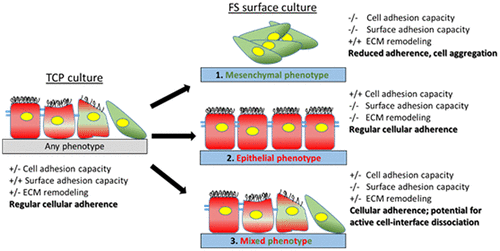当前位置:
X-MOL 学术
›
ACS Appl. Bio Mater.
›
论文详情
Our official English website, www.x-mol.net, welcomes your
feedback! (Note: you will need to create a separate account there.)
Materials-Based Approach for Interrogating Human Prostate Cancer Cell Adhesion and Migratory Potential Using a Fluoroalkylsilica Culture Surface
ACS Applied Bio Materials ( IF 4.6 ) Pub Date : 2020-01-07 , DOI: 10.1021/acsabm.9b00940 Matthew Nicklin , Graham J. Hickman , A. Graham Pockley , Carole C. Perry
ACS Applied Bio Materials ( IF 4.6 ) Pub Date : 2020-01-07 , DOI: 10.1021/acsabm.9b00940 Matthew Nicklin , Graham J. Hickman , A. Graham Pockley , Carole C. Perry

|
OPCT-1 is a heterogeneous prostate cancer cell line derived from primary (rather than metastatic) disease which contains epithelial, mesenchymal, and CD44high/CD24low cancer stem cell (CSC) subpopulations and from which we have previously generated and characterized stable mesenchymal (P4B6B) and epithelial (P5B3) cell subpopulations. In this contribution, we explore the effect of tissue culture surface chemistry (standard tissue culture plastic (TCP) and a fluoroalkylsilica (FS) culture surface with inherently low surface energy) on the phenotype and adherent capacity of mesenchymal and epithelial cell populations. We demonstrate that OPCT-1 cells adherent to FS surfaces comprise both epithelial- and mesenchymal-like populations; a mesenchymal subpopulation derived from OPCT1 (P4B6B) poorly adheres to FS and formed spheroids, whereas an epithelial subpopulation derived from OPCT1 (P5B3) forms an adherent monolayer. In contrast, P4B6B cells do adhere to FS when cocultured with P5B3 cells. Taken together, these findings demonstrate that EMT/cell differentiation status dictates cell adhesive capacity and provide a novel insight into the relationship between epithelial and mesenchymal cell populations in metastasis. Importantly, the differences in adherence capacity between P4B6B and P5B3 are not apparent using standard TCP-based culture, thereby highlighting the value of using alternative culture surfaces for studying cell surface interaction/adhesion phenomena and interrogating mechanisms involved in adhesion and detachment of metastatic tumor cells.
中文翻译:

使用氟烷基二氧化硅培养表面检测人类前列腺癌细胞粘附和迁移潜力的基于材料的方法
OPCT-1 是一种异质性前列腺癌细胞系,来源于原发性(而非转移性)疾病,包含上皮、间质和 CD44高/CD24低癌症干细胞 (CSC) 亚群,我们之前已经从中生成并表征了稳定的间充质 (P4B6B) 和上皮 (P5B3) 细胞亚群。在这篇文章中,我们探讨了组织培养表面化学(标准组织培养塑料 (TCP) 和具有固有低表面能的氟烷基二氧化硅 (FS) 培养表面)对间充质和上皮细胞群的表型和贴壁能力的影响。我们证明了粘附于 FS 表面的 OPCT-1 细胞包括上皮样和间充质样细胞群。源自 OPCT1 (P4B6B) 的间充质亚群很难粘附到 FS 并形成球体,而源自 OPCT1 (P5B3) 的上皮亚群形成粘附单层。相反,当与 P5B3 细胞共培养时,P4B6B 细胞确实粘附在 FS 上。综合起来,这些发现表明,EMT/细胞分化状态决定了细胞粘附能力,并为了解上皮细胞和间充质细胞群在转移中的关系提供了新的见解。重要的是,使用基于 TCP 的标准培养物,P4B6B 和 P5B3 之间的粘附能力差异并不明显,因此突出了使用替代培养表面研究细胞表面相互作用/粘附现象和询问转移性肿瘤细胞粘附和脱离所涉及的机制的价值.
更新日期:2020-01-07
中文翻译:

使用氟烷基二氧化硅培养表面检测人类前列腺癌细胞粘附和迁移潜力的基于材料的方法
OPCT-1 是一种异质性前列腺癌细胞系,来源于原发性(而非转移性)疾病,包含上皮、间质和 CD44高/CD24低癌症干细胞 (CSC) 亚群,我们之前已经从中生成并表征了稳定的间充质 (P4B6B) 和上皮 (P5B3) 细胞亚群。在这篇文章中,我们探讨了组织培养表面化学(标准组织培养塑料 (TCP) 和具有固有低表面能的氟烷基二氧化硅 (FS) 培养表面)对间充质和上皮细胞群的表型和贴壁能力的影响。我们证明了粘附于 FS 表面的 OPCT-1 细胞包括上皮样和间充质样细胞群。源自 OPCT1 (P4B6B) 的间充质亚群很难粘附到 FS 并形成球体,而源自 OPCT1 (P5B3) 的上皮亚群形成粘附单层。相反,当与 P5B3 细胞共培养时,P4B6B 细胞确实粘附在 FS 上。综合起来,这些发现表明,EMT/细胞分化状态决定了细胞粘附能力,并为了解上皮细胞和间充质细胞群在转移中的关系提供了新的见解。重要的是,使用基于 TCP 的标准培养物,P4B6B 和 P5B3 之间的粘附能力差异并不明显,因此突出了使用替代培养表面研究细胞表面相互作用/粘附现象和询问转移性肿瘤细胞粘附和脱离所涉及的机制的价值.











































 京公网安备 11010802027423号
京公网安备 11010802027423号